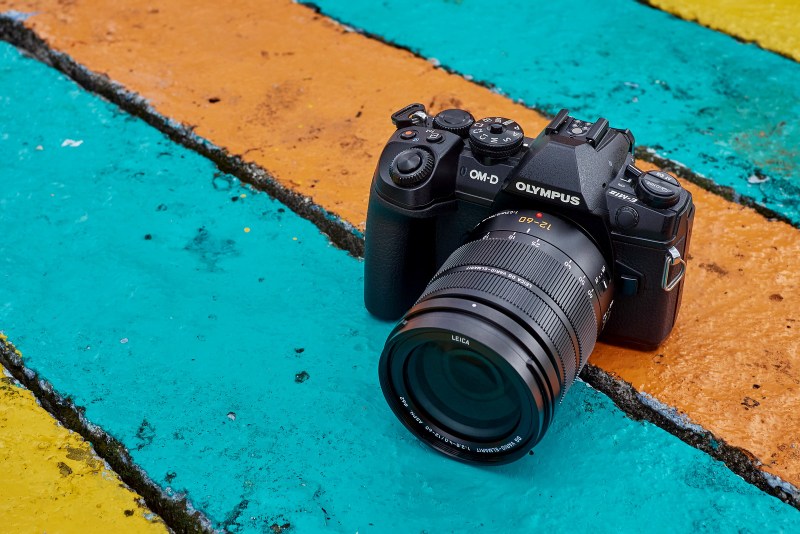Olympus and Panasonic have been releasing increasingly similar and overlapping lenses as the Micro Four Thirds system matures. More options and choice can definitely be seen as an advantage. Early this year, in January, Panasonic released the Panasonic Leica DG Vario-Elmarit 12-60mm F2.8-4.0 zoom lens. The other competitors for a similar zoom lens are: the Panasonic 12-35mm F2.8 and Olympus 12-40mm F2.8 at about the same price as the new 12-60mm F2.8-4. For a premium, you can have the Olympus 12-100mm F4, and at the lower end there is the Panasonic 12-60mm F3.5-5.6. There is no shortage of standard zoom lenses. Therefore in this review, I shall explore the capabilities of the Panasonic 12-60mm F2.8-4 and discuss how this lens stands out from the rest of the crowd.
My review unit of the Panasonic 12-60mm F2.8-4 lens was on loan from Panasonic Malaysia, and has been returned after this review. Neither MT nor I are associated with Panasonic Malaysia in any way, and this is an independent review. This is a user experience based review and my opinion may be subjective. All the images in this review were shot with the Panasonic 12-60mm F2.8-4 on Olympus OM-D E-M1 Mark II. All images were post-processed with Capture One Pro and high resolution images with EXIF data intact can be found in online gallery here.
Visually, the Panasonic 12-60mm F2.8-4 seems the same size as the Olympus 12-40mm F2.8. Weighing only 320g, the body construction feels solid and reassuring on my hands. The optical composition consists of 14 elements in 12 groups including 4 Ashperical lenses and 2 ED (extra low dispersion) lenses to correction distortion and various imaging aberrations. The minimum focusing distance is 0.2m, with maximum magnification of 0.3x. The lens is also weather sealed. For full product specifications, kindly visit Panasonic’s product page here.
The obvious question is whether the compromise of varying aperture (F2.8 to F4, instead of constant F2.8) is worth the extra reach?
I tested this lens under two distinct conditions. First, on a day trip to Pulau Ketam, a local fishing village where floating houses are built out in the sea on wooden stilts. This was an ideal setting to test the wider end of the lens, whereas the longer end was put to the test at the KL Bird Park.
At wide angles, the Panasonic 12-60mm F2.8-4 lens exhibits high levels of sharpness, even while shooting wide open. The sharpness is very even across the frame, and there is no noticeable degradation at the corners. Shooting conditions at Pulau Ketam were mostly overcast with intermediate sun shining through the clouds. The Panasonic 12-60mm F2.8-4 did a great job delivering images with a good amount of contrast and clarity. Stopping down the lens to F4 and F5.6, gives you a slight improvement in sharpness, but I would not hesitate to use the lens wide open if the situations calls for it.
At medium focal lengths (20-40mm), the lens performs at its peak in terms of sharpness. The output observed from these focal lengths is very close to what can be accomplished from using prime lenses (25mm and 45mm lenses). The amount of detail resolved is quite impressive. However, at the telephoto end, there is a noticeable drop in sharpness. In practical shooting circumstances, this is negligible, and should not be a cause for concern. The lens had no issues shooting the birds in KL Bird Park in overcast weather conditions. The head-shot portraits of the birds were taken at 60mm end, and I was pleased with the amount of detail the lens resolved.
Considering that the widest aperture is between F2.8 and F4, I did not expect the lens to produce a shallow depth of field effect. Nonetheless, bokeh rendered by this lens is creamy and smooth. Even stopping down to F5.6 or 6.3 for my macro shots, the bokeh balls were perfectly round and soft.
Handling of the Panasonic 12-60mm F2.8-4 felt exactly the same as the Olympus 12-40mm F2.8, which is a good thing, and I find that this is the perfect size for a Micro Four Thirds zoom lens. Any larger or heavier makes it uncomfortable for long hours of shooting, and any smaller or lighter will throw off the balance.
 f/22, 1/250, 12mm, ISO200, Flare is well controlled.
f/22, 1/250, 12mm, ISO200, Flare is well controlled.
 f/2.8, 1/6400, 12mm, ISO200, Intentionally shot at wide open, to test for chromatic aberration, which was well controlled
f/2.8, 1/6400, 12mm, ISO200, Intentionally shot at wide open, to test for chromatic aberration, which was well controlled
 f/5, 1/15, 12mm, ISO250, minimal distortion, and impressive corner sharpness
f/5, 1/15, 12mm, ISO250, minimal distortion, and impressive corner sharpness
 f/8, 1/60, 60mm, ISO200, close up shooting at maximum magnification of 0.3x
f/8, 1/60, 60mm, ISO200, close up shooting at maximum magnification of 0.3x
 f/5.6, 1/40, 60mm, ISO200, smooth and creamy out of focus areas, with round bokeh balls
f/5.6, 1/40, 60mm, ISO200, smooth and creamy out of focus areas, with round bokeh balls
 f/5.6, 1/80, 29mm, ISO200, a backlight situation, though less severe
f/5.6, 1/80, 29mm, ISO200, a backlight situation, though less severe
The lens shows very good technical flaw control, with no noticeable distortion and nearly perfectly straight lines at wide angles. Even if there is any barrel distortion, it can be easily corrected. I only saw minor traces of chromatic aberration, and I had to shoot wide open against direct backlight for this. Even so, without pixel-peeping, the chromatic aberration (purple fringing) is mostly negligible, and can be mitigated completely by stopping down to F4.
Flare is well controlled, and can be easily avoided. Kindly take note that in my test for flare, I did not use the lens hood. Thus, using the hood will probably eliminate any trace of flare altogether. I had to intentionally find an angle to catch the flare for the sample shot. Stopping the lens down all the way to F22, the starburst effect (due to aperture blades profile) is quite attractive.
At minimum shooting distance, the Panasonic 12-60mm F2.8-4 lens can achieve the maximum of 0.3x magnification, which is good enough for some close up shooting. At the Bird Park, I found a spider and two bugs and while the lens is not a macro lens, and we should not expect it to be, it was good enough in these situations. A little more magnification would be greatly appreciated (close to 0.5x), but that is just the insect macro shooter in me complaining.
On the whole, I personally feel that in terms of technical control alone (distortion, CA, flare control, etc.) the new Panasonic 12-60mm F2.8-4 may actually outperform the older Olympus 12-40mm F2.8 and Panasonic 12-35mm F2.8 lenses. The results from my short time with the lens were impressive.
The Panasonic 12-60mm F2.8-4 performed optimally on the Olympus OM-D E-M1 Mark II. Autofocus is snappy and extremely responsive at any focal length, and I managed to nail critical shots. The zoom mechanism is smooth and quick and I could frame my shots easily and quickly without issue. I believe the performance should be equally positive on Panasonic native bodies, if not better.
I did encounter a situation where I found myself struggling with the lens, but it wasn’t exactly the fault of the lens, as I was faced with an extremely dimly lit location for a live band performance. Shooting a stage performance with bad lighting, zooming in all the way to 60mm, F4 was simply not sufficient to allow me a fast enough shutter speed to freeze motion. At ISO6400, F4, I could only obtain about 1/30 second shutter speed. I needed at least 1/80 or 1/100 second to get acceptable images in this situation. Having a constant F2.8 aperture would’ve definitely helped. In this, the F1.8, or the more expensive F1.2 prime lenses can help keep ISO down, and save the day.
 f/6.3, 1/50, 40mm, ISO500, A sweet ending to the review test session.
f/6.3, 1/50, 40mm, ISO500, A sweet ending to the review test session.
After using the Panasonic 12-60mm F2.8-4 for several days, I was genuinely impressed by its technical flaw control, which I think surpasses other available standard zoom lens options. The lens is pleasant to use, quite sharp and is capable of delivering beautiful results.
Having said that, I personally would still go for the Olympus 12-40mm F2.8 or the Panasonic 12-35mm F2.8 – primarily for the constant aperture. In difficult lighting, the F2.8 versus F4 can make a world of difference. If you are a Panasonic user, it makes perfect sense to go for the Panasonic 12-60mm F2.8-4 to take advantage of the Dual Image Stabilization system, if your camera body has that feature. I would not hesitate to recommend this lens for Olympus users as well. I was happy with what the lens can do on an Olympus camera.
I know the question of the Olympus 12-100mm F4 will pop up sooner or later either in my email or the comments, so allow me to tackle it here. The performance between the Olympus 12-100mm and Panasonic 12-60mm F2.8-4 is very similar, but at longer range of the lens, the Olympus has a slight advantage in sharpness. It is also worth noting that the Olympus 12-100mm costs significantly more than the Panasonic 12-60mm. My review of the Olympus 12-100mm lens can be found here.
__________________
We are also on Facebook and there is a curated reader Flickr pool.
Images and content copyright Robin Wong 2017 onwards. All rights reserved




















Hi Robin, love your reviews. Would this lens work well with an old Olympus EP2? I’m currently looking for a do it all lens and I’m torn between the Oly 12-40 or this lumix Leica. Both look amazing.
Robin thanks for your always detailed reviews of MFT equipment and the generous presentation of lots of real world photos under a wide variety of conditions. This review was very helpful for me as this lens iis on my shortlist for purchase. Thanks!
This article is not on the Robin Wong archive list. I remembered this review so in the end I found it by using the search box.
You may also find it in my own summary of reviews here: https://robinwong.blogspot.my/p/olympus-gear-review.html
Thanks, that’s now been fixed. (Incidentally, first one I’ve missed putting in the archives in over 1,500 articles, so we’re not doing too badly! 🙂 )
How would the performance be onto the older Olympus OM-D M1 (Mark I) Body? Is that combo worth it? Means, this Lens onto the M1 I. I do think, AF Performance would be of course not that great, then…and perhaps IQ also a bit worse.
The FT Oly 12-60 was also formidable and I still have mine and use it regularly. The 12-60 is beckoning as my next choice though. I may never get round to swapping 12-60 out. I love the feel when it’s on the OMD.
Great review, excellent photos Robin. Yet another testament to the dominance of the Oly 12-40 that after fours years and many formidable challengers including this one, it remains the most versatile, do all, be all zoom lens in its class…perhaps even the best zoom ever? 😉
Thanks for the kind words. I would not go that far to say the best zoom lens ever, since I have not tried all zoom lenses available out there. The 12-40mm is quite formidable and it does what it does extremely well.
Thanks for the review, Robin. I know that it is hard (because the lens are loans), but a comparison with the cheaper 12-60mm f/3.5-5.6 would be great.
And, of course, this lens could be a little cheaper – like US$ 797,00;
I have decided that there will be no direct comparisons. People just do not appreciate that.
I bought this lens to travel with my Pen-F and have been pleased with the results, as well. Thanks foy sharing your insights.
I think it is a great combination with PEN-F! Good decision.
I’m so glad reviews are continuing (love the 12-100mm review by the way). There is certainly no lack of choice in this focal range. Gone are the days of the throwaway kit lens. Also very pleased to hear the purple fringing isn’t a problem with this lens on the EM1 MKII. I’ve seen, read and have experienced pretty bad purple fringing with Panasonic lens (Panasonic 25mm F1.4) on older EMI body. Wonder if something changed there.
Great job as always Robin.
Interestingly I did not notice much Chromatic Aberration (purple fringing) in this lens, even shooting at wide open. However, this lens did not start at F1.4, like the 25mm did. I believe it is easier to correct CA for smaller aperture lenses.
Wow! Those are great pictures!
Thanks Rebel Girl!
Thank you for the review: informative, as always 🙂
One question: how does the rear of the lens look, at the bayonet mount? … better than the weak Olympus 12-40?
I am holding back from getting the Oly after seeing too many fail (crack away) at the mount…
So far it seems sturdy, but then again I only had one week with it, and did not handle the lens very roughly. I do not think there is any problem at all. These issues will only arise after extensive use of course.